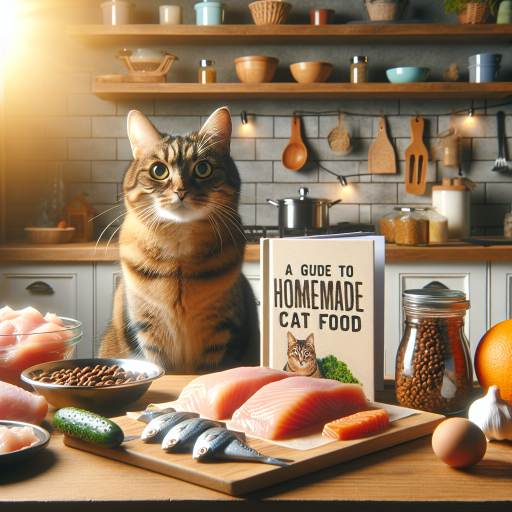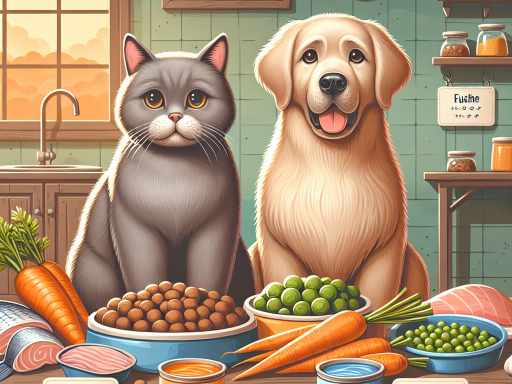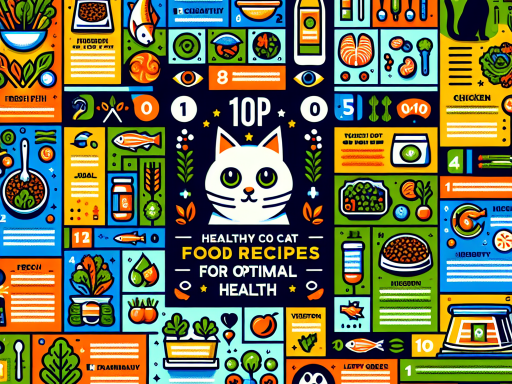Introduction to Homemade Cat Food
Are you considering making homemade cat food for your feline friend? Well, you’re in the right place! Creating meals from scratch for your cat can be a rewarding experience and a fantastic way to ensure they get the best nutrition possible. After all, we all want what’s best for our furry companions, don’t we?
Before you dive into the world of homemade cat cuisine, let’s cover some basics and why you might want to take this paw-some path.
Why Homemade Cat Food?
There are several great reasons to consider whipping up homemade meals for your kitty:
- Control Over Ingredients: When you prepare your cat’s food at home, you know exactly what’s going into each dish. This can be particularly important if your cat has food allergies or sensitivities.
- Customization: Every cat is unique; with homemade food, you can tailor meals to meet your cat’s specific preferences and dietary needs.
- Freshness: Fresh ingredients often mean higher nutrient content and better taste, which can be more appealing to your feline friend.
- Bonding Experience: Preparing food for your cat can strengthen the bond between you and your pet. Plus, it’s a fun way to show them just how much you care!
Is Homemade Cat Food Right for You?
Before you start planning your cat’s new menu, it’s important to consider a few factors:
- Time Commitment: Making cat food at home does require time and effort. If you have a busy schedule, this might not be the best option for you.
- Research: You’ll need to invest time in understanding feline nutrition to ensure your cat gets a balanced diet. Cats have specific dietary requirements that differ from humans and other pets.
- Consulting a Vet: Always talk to your veterinarian before making any significant changes to your cat’s diet. They can provide valuable insights and help you avoid any potential pitfalls.
Getting Started
If you’re still excited about the prospect of homemade cat food, great! Here’s how you can start:
- Learn About Feline Nutrition: Understanding what nutrients your cat needs is crucial. This includes proteins, fats, vitamins, and minerals that are essential for their health.
- Gather Recipes: Look for tested and vet-approved recipes to ensure you’re offering balanced meals. We’ll share some delicious recipes in another section of this guide.
- Start Simple: Begin with easy recipes and gradually expand your repertoire as you get more comfortable with the process.
Remember, the goal is to provide a diet that keeps your cat happy and healthy. Taking the time to learn and prepare the meals with love will make mealtime a joy for both you and your furry friend.
Ready to embark on this culinary adventure? Let’s get cooking!
Understanding Your Cat’s Nutritional Needs
Hey there, fellow cat lover! 🐱 Thinking about whipping up some homemade meals for your feline friend? That’s fantastic! But before you dive into the kitchen, it’s crucial to get a handle on what your furry buddy actually needs to stay healthy, active, and happy. Let’s break it down together!
Why It’s Important
Cats are obligate carnivores, which means they rely primarily on meat for their nutrients. Unlike dogs or humans, they can’t thrive on a plant-based diet alone. Understanding this fundamental aspect will help you create meals that meet all their dietary requirements.
What Nutrients Do Cats Need?
It’s not just about tossing some chicken in a bowl and calling it a day. Cats have specific nutritional needs that must be met for their overall well-being. Here’s a closer look:
- Protein: This is the star of the show. Cats need a high-protein diet to support their muscles, skin, and fur. Good sources of protein include chicken, turkey, beef, and fish.
- Taurine: This is an essential amino acid that cats can’t produce on their own. It’s crucial for heart health, vision, and reproduction. Taurine is found in animal tissues, particularly in heart and muscle meats.
- Fat: Fats provide energy and help absorb vitamins. They also keep your cat’s coat shiny and skin healthy. Fish oil, chicken fat, and other animal fats are excellent sources.
- Vitamins and Minerals: Cats need a variety of vitamins and minerals, including Vitamin A, D, E, and K, as well as calcium, phosphorus, and magnesium. These are vital for bone health, immune function, and overall vitality.
- Water: Hydration is key! Cats often get a lot of their water intake from their food, especially if they aren’t big water drinkers. Including moisture-rich foods can help keep them hydrated.
How Much is Enough?
So, how can you be sure you’re giving your cat the right amount of nutrients? All cats are different, but a good rule of thumb is to ensure that protein makes up about 30-40{7493f20db4b8ae176bcbf41d5f5213ca77630d75c7ca8b92d85b990b084e1c85} of their diet. Fat should be around 10-20{7493f20db4b8ae176bcbf41d5f5213ca77630d75c7ca8b92d85b990b084e1c85}, and the rest can be filled in with vitamins, minerals, and moisture.
Common Misconceptions
There are a few misconceptions out there about what cats need. Let’s debunk some of them:
- Myth: Cats can eat a vegan diet.
Fact: Cats are obligate carnivores and need animal proteins to thrive. - Myth: Milk is good for cats.
Fact: Most adult cats are lactose intolerant, and milk can cause digestive issues. - Myth: Cats don’t need much water.
Fact: Proper hydration is crucial, especially if they eat dry food.
Consult the Experts
Before you make any major changes to your cat’s diet, it’s a good idea to consult with a veterinarian or a pet nutritionist. They can help guide you towards the best choices for your individual cat’s needs.
Remember, your goal is to provide a balanced, nutritious diet that caters to the unique needs of your beloved feline. Armed with this knowledge, you’re well on your way to becoming a homemade cat food guru!
Happy cooking, and here’s to many purr-filled meals ahead! 🐾
Essential Ingredients for Homemade Cat Food
When it comes to preparing homemade cat food, it’s essential to include all the necessary ingredients to ensure your feline friend gets all the nutrients they need to thrive. Here are some key ingredients to include in your cat’s homemade meals:
- Protein: Cats are obligate carnivores, which means they require a diet high in animal protein. Include sources like chicken, turkey, beef, or fish in your cat’s meals to meet their protein needs.
- Taurine: Taurine is an amino acid that is crucial for cats’ heart health and vision. Make sure to include taurine-rich foods like organ meats (liver, heart) or supplement with a taurine powder to prevent deficiencies.
- Fats: Healthy fats are essential for your cat’s skin, coat, and overall health. Include sources of omega-3 and omega-6 fatty acids like fish oil, flaxseed oil, or chicken fat in their meals.
- Carbohydrates: While cats don’t need as many carbohydrates as other animals, they can still benefit from some in their diet. Include sources like cooked grains (rice, oats) or vegetables (sweet potatoes, peas) to provide energy and fiber.
- Vitamins and Minerals: To ensure your cat gets all the necessary vitamins and minerals, consider adding a feline multivitamin supplement to their meals. Alternatively, include foods like eggs, dairy, or leafy greens to provide a natural source of nutrients.
By incorporating these essential ingredients into your cat’s homemade meals, you can provide them with a balanced and nutritious diet that supports their overall health and well-being. Remember to consult with your veterinarian before making any significant changes to your cat’s diet to ensure it meets their specific nutritional needs.
“`html
Essential Ingredients for Homemade Cat Food
When it comes to preparing homemade cat food, it’s essential to include all the necessary ingredients to ensure your feline friend gets all the nutrients they need to thrive. Here are some key ingredients to include in your cat’s homemade meals:
- Protein: Cats are obligate carnivores, which means they require a diet high in animal protein. Include sources like chicken, turkey, beef, or fish in your cat’s meals to meet their protein needs.
- Taurine: Taurine is an amino acid that is crucial for cats’ heart health and vision. Make sure to include taurine-rich foods like organ meats (liver, heart) or supplement with a taurine powder to prevent deficiencies.
- Fats: Healthy fats are essential for your cat’s skin, coat, and overall health. Include sources of omega-3 and omega-6 fatty acids like fish oil, flaxseed oil, or chicken fat in their meals.
- Carbohydrates: While cats don’t need as many carbohydrates as other animals, they can still benefit from some in their diet. Include sources like cooked grains (rice, oats) or vegetables (sweet potatoes, peas) to provide energy and fiber.
- Vitamins and Minerals: To ensure your cat gets all the necessary vitamins and minerals, consider adding a feline multivitamin supplement to their meals. Alternatively, include foods like eggs, dairy, or leafy greens to provide a natural source of nutrients.
By incorporating these essential ingredients into your cat’s homemade meals, you can provide them with a balanced and nutritious diet that supports their overall health and well-being. Remember to consult with your veterinarian before making any significant changes to your cat’s diet to ensure it meets their specific nutritional needs.
“`
Recipes for Balanced Cat Meals
So, you’ve decided to take the plunge into the realm of homemade cat food. Good for you! It’s a fantastic way to ensure your feline friend is getting all the nutrients they need. But where do you start? Don’t worry, we’ve got you covered with some simple, balanced, and delicious recipes that your cat will love.
Chicken Delight
This is a great starter recipe that’s both nutritious and easy to prepare.
- Ingredients:
- 1 cup of cooked chicken breast (shredded)
- 1/2 cup of cooked carrots (mashed)
- 1/4 cup of cooked peas
- 1 tablespoon of fish oil
- 1/4 teaspoon of taurine supplement
- Combine the chicken, carrots, and peas in a mixing bowl.
- Add the fish oil and taurine, mixing until all ingredients are well-incorporated.
- Serve immediately or store in the refrigerator for up to 3 days.
Note: This recipe provides a balanced mix of protein, vitamins, and essential fatty acids. Taurine is crucial for your cat’s heart health, so don’t skip it!
Fish Feast
If your kitty is a fan of seafood, this recipe will be a big hit.
- Ingredients:
- 1 cup of cooked salmon (flaked)
- 1/2 cup of boiled sweet potatoes (mashed)
- 1/4 cup of cooked green beans (chopped)
- 1 tablespoon of olive oil
- 1/4 teaspoon of taurine supplement
- Mix the salmon, sweet potatoes, and green beans in a bowl.
- Stir in the olive oil and taurine until well-blended.
- Portion out the food and serve or refrigerate for up to 3 days.
Pro Tip: You can also use other fish like tuna or mackerel, but always ensure it’s fully cooked to avoid any harmful bacteria.
Beef and Veggie Medley
For cats that prefer the taste of red meat, this recipe is both tasty and nutritious.
- Ingredients:
- 1 cup of cooked ground beef (lean)
- 1/2 cup of cooked pumpkin (mashed)
- 1/4 cup of cooked spinach (chopped)
- 1 tablespoon of flaxseed oil
- 1/4 teaspoon of taurine supplement
- Combine the ground beef, pumpkin, and spinach in a bowl.
- Add the flaxseed oil and taurine, mixing thoroughly.
- Serve immediately or store in the fridge for up to 3 days.
Fun Fact: Pumpkin is great for your cat’s digestive system, adding more fiber to their diet.
Turkey and Rice Combo
This recipe is perfect for cats with a more sensitive digestive system.
- Ingredients:
- 1 cup of cooked turkey breast (shredded)
- 1/2 cup of cooked brown rice
- 1/4 cup of cooked zucchini (chopped)
- 1 tablespoon of safflower oil
- 1/4 teaspoon of taurine supplement
- Mix the turkey, brown rice, and zucchini in a bowl.
- Stir in the safflower oil and taurine until well-mixed.
- Serve or refrigerate for up to 3 days.
Hot Tip: Turkey is a lean protein that’s easy on the stomach, making it a great choice for cats with food sensitivities.
With these recipes, you’re well on your way to becoming a homemade cat food chef extraordinaire. Remember, balance is key to your cat’s health, and these recipes are a great way to start providing that in a tasty and nutritious form.
Foods to Avoid in Homemade Cat Food
Hey there, fellow cat parent! When it comes to preparing homemade cat food for your furry friend, it’s important to be aware of what ingredients to avoid. Just like us, cats have specific dietary needs that must be met to keep them healthy and happy. Here are some foods you should steer clear of when making homemade cat meals:
- Onions and Garlic: These can be toxic to cats and should never be included in their diet. They can cause damage to their red blood cells, leading to serious health issues.
- Chocolate: We all know that chocolate is a big no-no for cats (and dogs too!). It contains theobromine, which can be harmful and even fatal to our feline friends.
- Caffeine: Just like chocolate, caffeine is a big no-go for cats. It can cause restlessness, rapid breathing, heart palpitations, and even seizures in felines.
- Alcohol: Cats should never consume alcohol as it can lead to intoxication, coma, and even death. Keep those cocktails away from your furry friends!
- Dairy: While many cats love the taste of milk, most adult cats are lactose intolerant. Feeding them dairy products can lead to stomach upset and diarrhea.
- Raw Fish: While a small amount of cooked fish can be okay for cats, raw fish can contain harmful bacteria and parasites that can cause illness in our feline friends.
By avoiding these foods in your homemade cat meals, you can help ensure that your kitty stays healthy and thriving. Remember, it’s always best to consult with your veterinarian before making any significant changes to your cat’s diet. They can provide you with tailored advice based on your cat’s specific needs and health requirements.
So, keep these foods in mind when whipping up some homemade meals for your cat. Your furry friend will thank you for it with purrs and snuggles!
Tips for Transitioning to Homemade Cat Food
So, you’ve decided to make the switch to homemade cat food for your feline friend. That’s fantastic! Transitioning your cat’s diet, however, isn’t something you should rush. Cats can be notoriously finicky eaters, and sudden changes can upset their stomachs or cause them stress. Here’s a step-by-step guide to make the transition as smooth as possible for both you and your furry companion.
Start Slowly
Just like humans, cats can be sensitive to sudden dietary changes. Begin by introducing small amounts of homemade food mixed in with their regular food. Aim for about 10{7493f20db4b8ae176bcbf41d5f5213ca77630d75c7ca8b92d85b990b084e1c85} homemade food at first, gradually increasing the proportion over a couple of weeks.
- Week 1: 10{7493f20db4b8ae176bcbf41d5f5213ca77630d75c7ca8b92d85b990b084e1c85} homemade food, 90{7493f20db4b8ae176bcbf41d5f5213ca77630d75c7ca8b92d85b990b084e1c85} regular food
- Week 2: 25{7493f20db4b8ae176bcbf41d5f5213ca77630d75c7ca8b92d85b990b084e1c85} homemade food, 75{7493f20db4b8ae176bcbf41d5f5213ca77630d75c7ca8b92d85b990b084e1c85} regular food
- Week 3: 50{7493f20db4b8ae176bcbf41d5f5213ca77630d75c7ca8b92d85b990b084e1c85} homemade food, 50{7493f20db4b8ae176bcbf41d5f5213ca77630d75c7ca8b92d85b990b084e1c85} regular food
- Week 4: 75{7493f20db4b8ae176bcbf41d5f5213ca77630d75c7ca8b92d85b990b084e1c85} homemade food, 25{7493f20db4b8ae176bcbf41d5f5213ca77630d75c7ca8b92d85b990b084e1c85} regular food
- Week 5: 100{7493f20db4b8ae176bcbf41d5f5213ca77630d75c7ca8b92d85b990b084e1c85} homemade food
Watch for Signs of Acceptance
Pay close attention to how your cat reacts to the new food. Are they eating it eagerly, or are they being hesitant? Cats can be creatures of habit and may need some convincing. If your cat shows signs of resistance, slow down the transition process or add a favorite treat to the homemade food to make it more enticing.
Monitor Health and Weight
During the transition, keep a close eye on your cat’s health and weight. Sudden weight loss, lethargy, or gastrointestinal issues are red flags. If you notice any of these signs, consult your veterinarian immediately. It’s essential to ensure that your homemade diet is meeting all their nutritional needs.
Gradual Changes Within the Homemade Diet
Once your cat has fully transitioned to homemade food, don’t make sudden changes within the homemade recipes themselves. If you want to introduce new ingredients, do it gradually. Cats can be particularly sensitive to new textures and flavors.
Consistency is Key
Cats thrive on consistency. Try to keep feeding times and portions consistent. This helps your cat adjust and reduces any potential stress related to the new diet. Consistent mealtimes also allow you to monitor their eating habits more effectively, making it easier to spot any issues early on.
Hydration is Crucial
Ensure that your cat is drinking plenty of water during the transition. Homemade food can sometimes be higher in moisture compared to commercial dry food, but it’s still crucial to provide fresh water at all times. Proper hydration helps in digestion and overall well-being.
Consult Your Veterinarian
Before making any significant changes to your cat’s diet, it’s always a good idea to consult with your veterinarian. They can provide personalized advice based on your cat’s specific needs and ensure that the transition is both safe and beneficial.
Patience and Persistence
Remember, patience is key. Transitioning to homemade cat food is a process, not an overnight change. Stick with it, and be persistent. The benefits of a balanced, homemade diet can significantly contribute to your cat’s long-term health and happiness.
By following these tips, you’ll be well on your way to successfully transitioning your cat to homemade food. Your feline friend will thank you for the effort and care you’re putting into their meals!
Welcome back, cat lovers! So, you’ve decided to take the plunge into making homemade cat food for your furry friend. Congratulations on taking such a proactive step towards ensuring your cat’s health and well-being. Now that you’ve got your recipes sorted and your ingredients ready, it’s important to remember that monitoring your cat’s health and adjusting their diet as needed is crucial to their overall well-being.
1. Regular Vet Check-ups
Before you embark on the homemade cat food journey, it’s essential to schedule a visit to the vet. Your vet can provide valuable insight into your cat’s specific nutritional needs and give you guidance on how to tailor their diet accordingly. Regular check-ups will also help you monitor your cat’s weight, body condition, and overall health.
2. Monitor Weight and Body Condition
Keep an eye on your cat’s weight and body condition to ensure they are maintaining a healthy physique. If you notice any sudden weight loss or gain, it’s time to reassess their diet and make necessary adjustments. Your vet can help you determine the ideal weight range for your cat based on their breed, age, and activity level.
3. Look Out for Nutritional Deficiencies
While homemade cat food can be nutritionally balanced, it’s important to watch out for any signs of deficiencies. Common deficiencies include taurine, an essential amino acid for cats, and vitamin A. If you notice any symptoms like lethargy, dull coat, or digestive issues, consult your vet to address any potential deficiencies in your cat’s diet.
4. Adjusting Portion Sizes
As your cat’s activity level, age, or health changes, you may need to adjust their portion sizes accordingly. Keep an eye on how much your cat is eating and their overall appetite. If your cat starts to gain or lose weight, it’s time to tweak their portion sizes to ensure they are getting the right amount of nutrients without overeating or undereating.
5. Incorporate Variety
Just like us, cats enjoy variety in their diet. Rotate different protein sources, fruits, and vegetables to provide a range of nutrients and flavors for your cat. This not only keeps mealtime exciting for your feline friend but also ensures they are getting a diverse range of nutrients to support their overall health.
Remember, every cat is unique, and what works for one cat may not work for another. Pay attention to your cat’s individual preferences, health needs, and reactions to certain ingredients. By staying vigilant and proactive in monitoring your cat’s health and adjusting their diet as needed, you can ensure they lead a happy and healthy life on homemade cat food.





